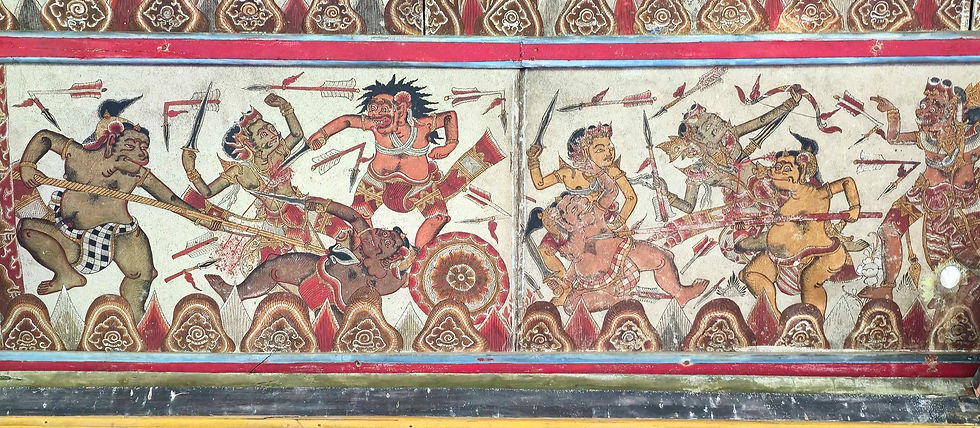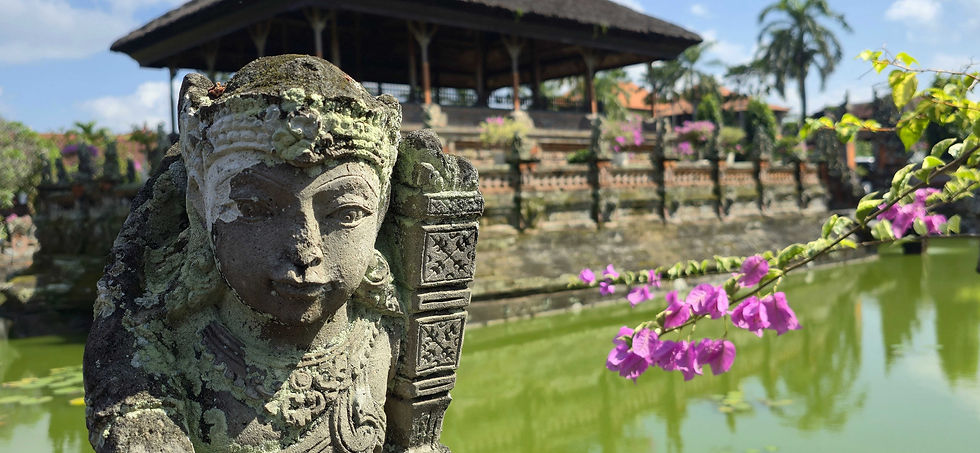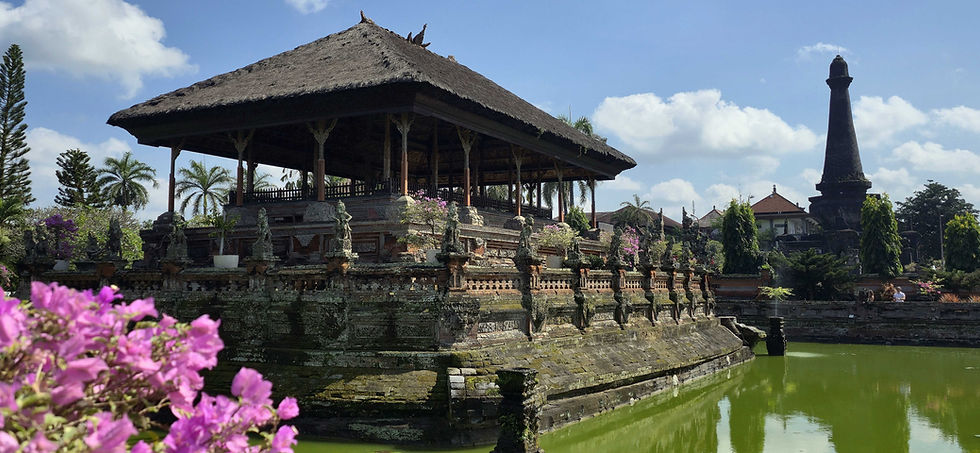Kerta Gosa Pavilion
- Shannon
- Sep 23
- 5 min read
Ancient Rituals and the Rule of Law
Originally built in the mid 17th century during the reign of Dewa Agung Jambe I, King of the ancient Klungkung Kingdom, the Kerta Gosa Pavilion first served a sacred function. As shown through the earliest ceiling paintings, the pavilion was a site for manusa yadnya, rituals of passage such as tooth-filing, marriage and coming of age ceremonies. Yet this was no ordinary ceremonial space. Over time, Kerta Gosa evolved into a place where matters of law, morality and fate were weighed with chilling intensity. Its very name, derived from Sanskrit, "Kerta" meaning "prosperity" or "result" and "Gosa" meaning "discussion", reflects its dual role as both spiritual sanctuary and court of deliberation. Justice here was administered by kings, Brahmin priests and nobles who passed judgement on everything from petty disputes to capital crimes.

The most haunting legacy of the Kerta Gosa Pavilion lies in its ceiling murals, vivid, chilling visions rendered in the traditional Kamasan style, descended from ancient Javanese wayang (shadow puppet) iconography. Likely first painted in the mid 19th century, these layered panels illustrate not only the divine structure of the cosmos but the brutal consequences of karma in the Balinese underworld, naraka. One side features Swarga, the realm of judgement, where Yama, the God of the Underworld, oversees the torments inflicted on sinful souls. Beneath him, scenes unfold in grim sequence. Liars sit beneath the punyan curiga (tree of daggers) and are impaled through the lips or eyes. Adulterers have their genitals scorched. Thieves, traitors and corrupt officials are boiled in grotesque cauldrons of punishment. Each act of moral failure is matched with a fate designed not only to terrify but to teach. These murals don’t merely illustrate mythology, they serve as a stark, unavoidable sermon on cause and consequence.

What makes Kerta Gosa particularly unsettling is that these paintings were not symbolic b
background, they functioned as part of the judicial system itself. Justice in this pavilion was administered directly beneath the gaze of the gods and demons depicted above. Royal judges and Brahmin priests passed down rulings while the condemned sat beneath scenes of eternal suffering, forced to contemplate the spiritual price of their earthly crimes. The lower registers of the murals emphasise purgatory, ensuring that no sin felt minor once visualized in such horrific detail. Whether one was facing a minor fine or a death sentence, the reminder was clear, punishment extended far beyond this life. The weight of divine retribution, rendered in full colour overhead, lent the court's decisions a supernatural gravity. Here, law and religion were inseparable and the painted ceiling did not forgive.

In 1908, Kerta Gosa became the blood soaked stage for one of Bali’s most devastating acts of defiance, the Puputan of Klungkung. As Dutch colonial forces launched their final assault on the Klungkung Palace, the King, Dewa Agung Jambe II, refused surrender. Clad in ceremonial white, he led his family, priests and loyal retainers, over 200 men, women and children, in a mass ritual suicide on the very palace grounds. With kris daggers drawn, they marched toward the rifles of the Dutch, choosing death with dignity over subjugation. The air rang with the cries of the wounded and the chant of prayers, before falling into a harrowing silence broken only by gunfire. Bodies lay in heaps on the steps of Kerta Gosa and throughout the palace, the ground thick with blood and scorched offerings. It was not merely a political defeat but a cultural and spiritual catastrophe. Kerta Gosa, once a beacon of justice and sacred law, stood scarred and silent, its murals of cosmic punishment now mirrored by the brutal annihilation of a kingdom.

“Puputan” means “to come to an end,” refering to the ritual mass suicide chosen by kings and warriors who refuse surrender, fighting to the death when submission was never an option
Post conquest, the Dutch preserved the pavilion not out of reverence but as a tool of soft power. They kept the murals intact, not to honour Balinese tradition but to subtly reinforce colonial control through familiar symbols of fear and morality. The vivid depictions of karma and eternal punishment served a new master, their spiritual authority co-opted to lend legitimacy to foreign rule. Trials continued beneath the watchful eyes of the gods but the judges now answered to a distant empire. Local beliefs were manipulated not abolished and were weaponised to suppress dissent and maintain order without open resistance. The gods above remained the same but the hands that wielded judgment had changed, rendering Kerta Gosa a relic caught in the grip of political theater and spiritual coercion, its sacred walls echoing with the dissonance of faith used against its own people.

Even today, a visit to Kerta Gosa carries a weight. The air is thick, not just with history but with the psychic residue of generations judged and condemned. Local guides speak in hushed tones and some refuse to linger beneath the ceiling for long. Offerings are often discreetly placed at the pavilion’s corners, perhaps in fear that the spirits of the damned still swirl beneath the wooden beams, restless and watching. Kerta Gosa remains more than a monument, it is a mirror of Bali’s darker spiritual and political realities. Here, justice was never blind. It was graphic, godly and eternal. It did not forgive. And in the stillness of the hall, beneath the flaking torment of the ceiling frescoes, one might still feel the lingering breath of verdicts whispered across centuries.

🗺️ Location
Jalan Kenanga No. 11, Semarapura Kelod, Klungkung Regency, Bali, Indonesia
🚆 How to get there
Klungkung Royal Palace is located within the Kertha Gosa park complex and is easily accessible from major Balinese hubs. It's roughly 30 minutes from Sanur, 45 minutes to an hour from Ubud and about 1 1/2 hours from Denpasar. Each route offers a scenic drive through rice fields and traditional villages, making the journey as enriching as the destination itself. You will likely pass this place on your way north or south, so have your driver stop in on the way.
⭐ Attraction Info
The Kerta Gosa Pavilion is open daily between 8am - 5pm, with tickets sold at the official counter located beside the Puputan Monument on the opposite side of the road. Entry costs 50,000 IDR and includes access to the Bale Kambang and the Klungkung Palace complex, as well as the onsite museum. Be cautious of self proclaimed tour guides who may approach you insisting you need to pay them directly, as this is a common scam. The site is small and easy to navigate on your own, so a guide is not necessary. As with most sacred places in Bali, a sarong is required to cover your knees. I strongly recommend carrying your own to avoid dealing with aggressive vendors trying to sell or rent you one at nearly every historical site. Allow yourself 30 to 60 minutes to explore the complex and take in the surroundings at a relaxed pace.

Thanks for reading about Kerta Gosa Pavilion. Check out more awesome destinations here!






































